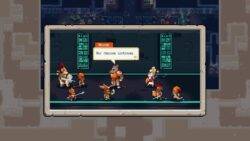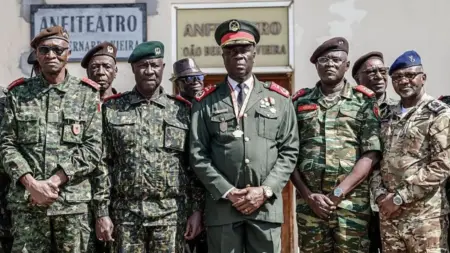Wargroove 2 – the mice are cute but misguided (Picture: Chucklefish)
The fantasy homage to Advance Wars gets a sequel with a new faction, three new campaigns, and an entirely new roguelike mode.
Advance Wars has always been a GameCentral favourite but for decades there’s only ever been the odd indie homage to keep the memory of the franchise alive. That’s especially true since sister series Fire Emblem became an unexpected hit, although we did at least get a remake of Advance Wars’ two Game Boy Advance titles this year. It was hard to tell exactly how successful it was though, and Nintendo has not hinted at any further plans for the franchise.
The next best thing has been 2019’s Wargroove, which was a blatant clone, that lacked the elegant simplicity of Advance Wars, but did manage to offer a similar level of complex but accessible turn-based combat. It did so with a fantasy theme, rather than Advance Wars’ modern day setting, but in almost every other respect it was as close to an unofficial sequel as you could imagine.
Inevitably, it was never quite so perfectly formed, with some rather ugly pixel art and sprawling map designs, but at least one of those problems has been addressed in this sequel, which is bursting with content and an endearing desire to please.
We’ll be honest, we’d completely forgotten what the story was in the original and the sequel doesn’t do a terribly good job of bringing you up to speed. Suffice to say there was a massive war amongst the various fantasy races and that zombies and magic weapons were involved.
The premise of Wargroove 2 is quite interesting though in that you start off in control of a new faction of anthropomorphic mice, who go recklessly in search of hidden magical weapons and stir up a whole new wave of trouble.
The storytelling isn’t deep but it’s interesting that you essentially start off by playing the bad guys – even if they’re not moustache-twirling villains – and it’s a shame the game doesn’t lean into that more. It’s also a pity that the three different story campaigns don’t connect as often as they did in the first game. There is an over-arching plot, but it’s not as tightly woven as before.
We’re sad to say we still don’t like the 2D pixel art, which seems to be trying to ape the abilities of a Game Boy Advance but just ends up with murky-looking sprites which are difficult to discern from one another. This problem is exacerbated by the fact that the basic unit types, like archer and calvary, all have different names depending on which faction it is – so you constantly have to look up which is which.
This is only mitigated by the fact that, apart from the mice and pirates, most of the other factions are largely the same, including in terms of their commanders. These have always been the biggest divergence from Advance Wars, as instead of simply being off-screen characters the commanders in Wargroove are actual units with unique abilities, which now have a two-tier charge meter instead of just one.
There are other key differences between Advance Wars and Wargroove, such as the way occupied villages work in terms restoring health to injured units, but the action still plays out across a grid-based map, where everyone gets to move and perform an action once per turn. The basics can be picked up in moments, although learning the intricacies of the different factions and unit types – from anti-air characters to healers – takes a little longer.
Clearly learning from complaints about the first game, the initial story campaign is easy even for novices, while it sensibly blocks off the maps to be as small as possible. They still tend to be larger than even the biggest Advance Wars maps, which isn’t necessarily a good thing, but they are much more varied than Nintendo’s, in terms of terrain (which affects your defence) and interactive features like earthquakes.
Criticising Wargroove 2 for not adding more new features is not entirely fair as that’s not something Advance Wars is known for either, or at least not successfully. What new additions Wargroove 2 does make are usually welcome, such as the ability to equip ordinary units with unique weapons or equipment to make them stronger or give them new abilities. Although, as with working out which unit is which, the game is strangely reticent to tell you what any of them actually do.
Wargroove 2 – the maps can still be a bit unwieldy (Picture: Chucklefish)
Rather than any major changes to the gameplay or factions, arguably the biggest new addition in Wargroove 2 is Conquest mode, which is basically an entirely separate rougelike game using the same units and gameplay.
It’s like playing a procedurally-generated Fire Emblem, with permadeath turned on, and considerably harder than any of the campaigns. It’s a fun and substantial mode but the high degree of randomisation, especially in terms of what enemies you face, can easily frustrate, especially as its inclusion means there’s no arcade or puzzle mode anymore.
It may not be the most daring sequel ever, but Wargoove 2 is a solid follow-up that, even though it must now bear a more direct comparison with Advance Wars, comes out looking very good. What new ideas there are work well and few games offer better value for money this year… or as many talking mice people.
In Short: The debt to Advance Wars still overshadows it, but despite a relative lack of new features this is a solid sequel to one of the best indie strategy games of the last few years.
Pros: Accessible but deep strategy combat with lots of different factions and units. Tons of content and some interesting story concepts. Conquest mode is a welcome, if occasionally frustrating, extra.
Cons: Not many new ideas and disappointingly few new units and commanders. Ugly visuals lack the retro charm the game as obviously going for. Identifying units and items is needlessly difficult.
Score: 8/10





